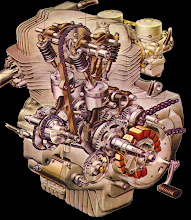
Riders in the UK will probably remember the CB450DX, the CB350S and the CB450S. These models were produced by Honda in Brazil for the European market. The CB450DX continued largely where the CB400N left off, but the CB350S and CB450S (which sold best in Germany) featured a very interesting tubular trellis frame very similar to the sporting frames produced by Harris in the UK and were fine handling, reliable bikes popular with dispatch riders and those looking for good honest motorcycling. More on these later...
But why Brazil?
Honda’s policy in the early to mid-1970s was "producing products in the markets where they are sold" and to find markets suitable for growth of the motorcycle segment.
In September 1975 Honda began production of a new manufacturing facility in Manaus, Brazil. It was originally going to be in Sao Paulo but the restrictions in that area forced Honda to look elsewhere. Manaus was a free-trade port way up the Amazon and Honda received very good tax breaks in setting up there.

Due to the distance from the main automotive manufacturing sectors in and around Sao Paulo, the new Honda factory would make a high proportion of parts in-house.

Beginning with the ubiquitous CG125, Moto Honda da Amazonia Ltda.(HDA) quickly grew to produce a high volume of motorcycles and several models, including the CB400 in 1980. The 3 valve engine for the CB400 was imported from the Honda factory at Kumamoto in Japan but most other components were manufactured locally.
Brazil’s bike market at the time of the CB400 being released was dominated by smaller models, including Honda’s own 125cc and 180cc models. Whereas in Europe, Japan and the United States the CB400 was never considered a large or particularly high performance machine, in Brazil it was a step above the smaller bikes, indeed, only the VW Beetle powered Amazonas was larger.
Physically bigger than the swarms of small bikes, lots more power and torque and with good handling characteristics it gave Brazilian buyers a real motorcycling experience.

In 1983 the CB450 was released with the engine capacity rising from 395cc to 447cc. Power improved slightly, torque improved significantly. These new engines were assembled in Brazil. The CB400 model received a facelift to match the new 450 and remained on sale for one year after the release of the CB450.
A number of variations on the CB450 were released including the Sport version which featured a bikini fairing but no actual increase in power. But the adverts sure made it look fast!

The styling on the Brazilian CBs was similar to that of the Super Dreams in other markets but with some subtle differences to tank and side panel shape. HDA discontinued the use of Comstar wheels in 1983, opting instead for cast aluminum wheels with six spokes (in three pairs).

For most of the 1980s the CB400/450 was the largest capacity motorcycle available in Brazil, and even now that larger bikes are being imported they are often very expensive. The result is that the CB models are still popular, and there are many great customized Brazilian CB400s.




No comments:
Post a Comment